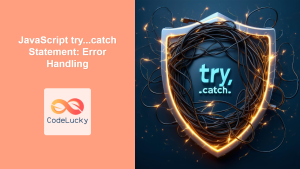Java's robust exception handling mechanism is one of its standout features, providing developers with powerful tools to manage errors and unexpected situations in their code. Two key players in this arena are the throw keyword and the throws clause. These elements allow programmers to create and manage custom exceptions, leading to more precise error handling and cleaner, more maintainable code.
Understanding the Throw Keyword
The throw keyword in Java is used to explicitly throw an exception. It's a way for developers to signal that something unexpected or erroneous has occurred in their code. When you throw an exception, you're essentially creating an object of the exception class and then using throw to hand it over to the Java runtime system.
Let's look at a simple example:
public class AgeValidator {
public static void validateAge(int age) {
if (age < 0) {
throw new IllegalArgumentException("Age cannot be negative");
}
System.out.println("Age is valid: " + age);
}
public static void main(String[] args) {
validateAge(25); // This will work fine
validateAge(-5); // This will throw an exception
}
}
In this example, we're throwing an IllegalArgumentException if someone tries to set a negative age. When you run this code, you'll see:
Age is valid: 25
Exception in thread "main" java.lang.IllegalArgumentException: Age cannot be negative
at AgeValidator.validateAge(AgeValidator.java:4)
at AgeValidator.main(AgeValidator.java:11)
🚀 Pro Tip: Use throw when you want to signal that something unexpected has happened in your code. It's a great way to catch errors early and provide meaningful feedback.
The Power of Custom Exceptions
While Java provides a rich set of built-in exceptions, sometimes you need something more specific to your application. This is where custom exceptions come in handy. Let's create a custom exception for our age validation example:
public class NegativeAgeException extends Exception {
public NegativeAgeException(String message) {
super(message);
}
}
public class AgeValidator {
public static void validateAge(int age) throws NegativeAgeException {
if (age < 0) {
throw new NegativeAgeException("Age cannot be negative: " + age);
}
System.out.println("Age is valid: " + age);
}
public static void main(String[] args) {
try {
validateAge(25); // This will work fine
validateAge(-5); // This will throw our custom exception
} catch (NegativeAgeException e) {
System.out.println("Caught exception: " + e.getMessage());
}
}
}
When you run this code, you'll see:
Age is valid: 25
Caught exception: Age cannot be negative: -5
🎯 Key Point: Custom exceptions allow you to create more meaningful and specific error types, improving the clarity and maintainability of your code.
The Throws Clause: Declaring Exceptions
The throws clause is used in method declarations to specify that this method might throw certain types of exceptions. It's a way of saying, "Hey, if you're going to use this method, be prepared to handle these exceptions!"
Let's modify our AgeValidator example to illustrate this:
public class AgeValidator {
public static void validateAge(int age) throws NegativeAgeException {
if (age < 0) {
throw new NegativeAgeException("Age cannot be negative: " + age);
}
System.out.println("Age is valid: " + age);
}
public static void main(String[] args) {
try {
validateAge(25);
validateAge(-5);
} catch (NegativeAgeException e) {
System.out.println("Caught exception: " + e.getMessage());
}
}
}
In this example, validateAge declares that it might throw a NegativeAgeException using the throws clause. This forces the calling code (in this case, main) to either handle the exception or declare that it throws the exception as well.
💡 Remember: The throws clause is all about declaring what exceptions a method might throw. It doesn't actually throw the exception – that's still done with the throw keyword.
Checked vs Unchecked Exceptions
Java has two main categories of exceptions: checked and unchecked. Understanding the difference is crucial for effective exception handling.
Checked Exceptions
Checked exceptions are exceptions that the compiler forces you to either handle (with a try-catch block) or declare (with the throws clause). These are typically used for recoverable conditions.
Example of a checked exception:
public class FileReader {
public static String readFile(String filename) throws IOException {
// Code to read file goes here
return "File contents";
}
public static void main(String[] args) {
try {
String content = readFile("example.txt");
System.out.println(content);
} catch (IOException e) {
System.out.println("Error reading file: " + e.getMessage());
}
}
}
In this example, IOException is a checked exception. The readFile method declares that it might throw this exception, and the main method is forced to handle it.
Unchecked Exceptions
Unchecked exceptions, also known as runtime exceptions, don't need to be declared or caught explicitly. These are typically used for programming errors that are not recoverable.
Example of an unchecked exception:
public class ArrayIndexDemo {
public static void main(String[] args) {
int[] numbers = {1, 2, 3};
System.out.println(numbers[5]); // This will throw an ArrayIndexOutOfBoundsException
}
}
When you run this code, you'll see:
Exception in thread "main" java.lang.ArrayIndexOutOfBoundsException: Index 5 out of bounds for length 3
at ArrayIndexDemo.main(ArrayIndexDemo.java:4)
🔍 Note: ArrayIndexOutOfBoundsException is an unchecked exception. We didn't need to declare it with throws or catch it explicitly.
Best Practices for Using Throw and Throws
-
Be Specific: When creating custom exceptions, make them as specific as possible. This makes your code more self-documenting and easier to debug.
-
Use Checked Exceptions for Recoverable Conditions: If the calling code can reasonably be expected to recover from the exception, make it a checked exception.
-
Use Unchecked Exceptions for Programming Errors: If the exception indicates a programming error (like trying to access an array index that doesn't exist), use an unchecked exception.
-
Don't Overuse Exceptions: Exceptions should be for exceptional circumstances. Don't use them for normal flow control in your program.
-
Always Include Meaningful Error Messages: When throwing an exception, include a clear and informative error message. This will make debugging much easier.
-
Clean Up Resources: If your method acquires resources (like file handles or database connections), make sure to clean them up in a
finallyblock or use try-with-resources.
Here's an example incorporating some of these best practices:
public class BankAccount {
private double balance;
public BankAccount(double initialBalance) {
if (initialBalance < 0) {
throw new IllegalArgumentException("Initial balance cannot be negative");
}
this.balance = initialBalance;
}
public void withdraw(double amount) throws InsufficientFundsException {
if (amount > balance) {
throw new InsufficientFundsException("Insufficient funds: trying to withdraw " + amount + " from balance of " + balance);
}
balance -= amount;
}
public static void main(String[] args) {
try {
BankAccount account = new BankAccount(100);
account.withdraw(50); // This is fine
account.withdraw(100); // This will throw an exception
} catch (InsufficientFundsException e) {
System.out.println("Transaction failed: " + e.getMessage());
}
}
}
class InsufficientFundsException extends Exception {
public InsufficientFundsException(String message) {
super(message);
}
}
In this example:
- We use an unchecked exception (
IllegalArgumentException) for a programming error (trying to create an account with negative balance). - We use a custom checked exception (
InsufficientFundsException) for a recoverable condition (trying to withdraw more money than is in the account). - We include meaningful error messages in our exceptions.
- We handle the checked exception in the calling code.
Conclusion
Mastering the use of throw and throws in Java is crucial for writing robust, error-resistant code. By understanding when and how to use these keywords, along with custom exceptions, you can create more maintainable and self-documenting code. Remember, effective exception handling is not just about catching errors – it's about providing meaningful information about what went wrong and why, making your software more reliable and easier to debug.
🏆 Challenge: Try creating a custom exception hierarchy for a more complex system, like an e-commerce platform. Think about what kinds of exceptions you might need (OrderNotFoundException, PaymentFailedException, etc.) and how you would use throw and throws to manage these in your code.
By leveraging Java's exception handling mechanisms effectively, you're well on your way to becoming a more proficient and thoughtful Java developer. Keep practicing, and soon throwing and catching exceptions will become second nature!



















